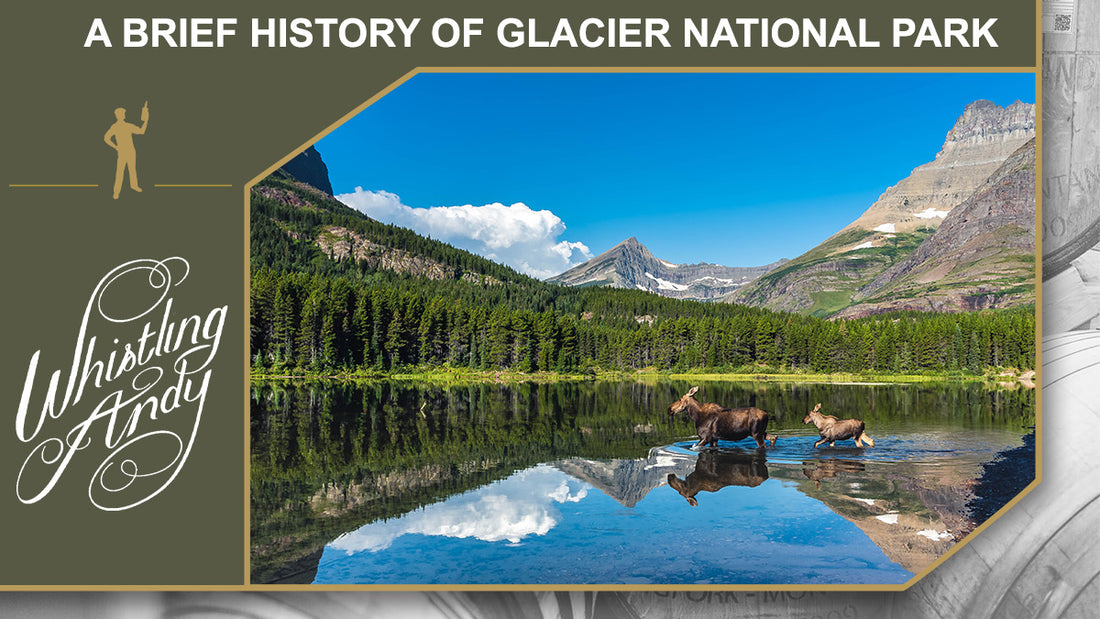The area that we know as Glacier National Park, all million-plus acres, has a history that dates back a mind-boggling 1.6 billion years. The site is a gold mine of information for geologists across the world, and it is a beloved National Park that is visited by upwards of 3 million people each year.

Though it would be entirely impossible to recount the park’s history in any great detail, we briefly look at how the area came to be, its early inhabitants, how it came to be the national treasure that it is today, and how it is still a work in progress.
In the Beginning
When gazing upon the “Crown of the Continent,” one finds themself in awe of its beauty and wondering how such beauty formed.
As recently as 20,000 years ago, the entire area we know to be Glacier National Park was completely engulfed in ice. The glaciers were formed when there was more snow in the winter than melted the previous summer, and as the snow accumulates, its weight is pressed down and creates ice in the layers below. The glacier can move because the bottom layer of ice becomes flexible, and, as it moves, it shapes the landscape by picking up dirt and debris that it passes.

The movement of these glaciers is how the park’s valleys, mountains, and over 200 lakes were formed, giving the area its breathtaking, rugged landscape.
Though there are over 50 glaciers that still exist in the park today, there are fewer, and the remaining ones are much smaller than they were all those thousands of years ago.
The First Settlers
There is evidence that people have inhabited the area that is now Glacier National Park for at least 10,000 years. Prior to the coming of European explorers and American settlers, several Native American tribes called the land their home.

Even today, the Blackfeet Indians help maintain and preserve the area as they believe it to be sacred territory belonging to their gods.
Eventually, European explorers came to Montana in a quest for the pelts of indigenous animals. Soon after, those searching for gold and oil made their way into the territory, and they were quickly followed by settlers looking to build homesteads. 1891 brought about the completion of the Great Northern Railway, making the beautiful area accessible to even more people searching for a new home. Soon, small towns popped up all around the vicinity of what is now Glacier National Park.

Also, around that time, those who came to the area began to see it was more than a place to look for gold or land to farm; it held beauties beyond almost anything anyone had beheld before. That is when people began to step up and do what they could to preserve the area’s integrity.
Becoming Glacier National Park
1885 was an important year in the creation and preservation of Glacier National Park. That was the year that George Bird Grinnell first visited the area. He was so taken by the area’s natural beauty that he began what would be a 20-plus-year history of advocating for Glacier.

Grinnell was a huge proponent of the development of the National Parks system, and he worked tirelessly to lobby Congress to recognize the region as such. In 1910, Grinnell’s dreams came to fruition when President Taft signed Glacier National Park into existence.
In an effort to promote the park as a land comparable to Switzerland, the Great Northern Railway helped build several hotels and chalets near Glacier to bring more tourists to the area. 1932 ushered in the completion of the Going-to-the-Sun Road, a 53-mile modern engineering marvel, giving automobiles access to drive through the park. It remains a must-see tourist attraction for those who visit Glacier.

This same year was monumental for Glacier in another way, as well. Along with Canada’s Waterton Lakes National Park, Glacier became one-half of the first International Peace Park. The two countries, along with the Blackfeet tribe, work in harmony to help preserve the parks and prevent forest fires, among other things.
In response to the unemployment rate during the Great Depression, President Franklin D. Roosevelt created the Civilian Conservation Corps (CCC). The CCC gave jobs to thousands of unemployed men across the country. From 1933 through 1943, the CCC was responsible for improvements to Glacier on a massive scale, and they were responsible for things that included:
- Reforestation.
- The creation of multiple trails and camping sites.
- Forest fire prevention measures.
- Environmental efforts to help ensure the park’s preservation.
In 1995, the International Peace Park was named a World Heritage Site.
Still a Work in Progress
As anyone who is environmentally conscious will attest, Global Warming is real. Few places in the world are feeling the effects of this phenomenon than Glacier National Park.

As previously stated, the park is still home to over 50 glaciers of various sizes; however, as recent as 20,000 years ago, the entire area we now know to be Glacier National was covered entirely in ice. Today, the glaciers that remain are considerably smaller than they once were, and there are notably fewer still in existence.
Luckily, so many people have been entranced by Glacier National’s beauty that there are a tremendous amount of conservation measures in place to ensure that the park remains as pure and clean as possible to preserve the area for generations to come.
A Brief History of Glacier National Park: An American Beauty
There are many amazing places to visit across the world, but most pale in comparison to the beauty and wonder that can be found in Glacier National Park.

Over a century after the park’s inception and over a billion years since the area that would become the park was formed, locals, tourists, and those who find it to be a sacred place revere the land, and for good reason.
Glacier National Park is the epitome of American beauty.





